Joseph G. Lambourne
BrepGen: A B-rep Generative Diffusion Model with Structured Latent Geometry
Jan 28, 2024Abstract:This paper presents BrepGen, a diffusion-based generative approach that directly outputs a Boundary representation (B-rep) Computer-Aided Design (CAD) model. BrepGen represents a B-rep model as a novel structured latent geometry in a hierarchical tree. With the root node representing a whole CAD solid, each element of a B-rep model (i.e., a face, an edge, or a vertex) progressively turns into a child-node from top to bottom. B-rep geometry information goes into the nodes as the global bounding box of each primitive along with a latent code describing the local geometric shape. The B-rep topology information is implicitly represented by node duplication. When two faces share an edge, the edge curve will appear twice in the tree, and a T-junction vertex with three incident edges appears six times in the tree with identical node features. Starting from the root and progressing to the leaf, BrepGen employs Transformer-based diffusion models to sequentially denoise node features while duplicated nodes are detected and merged, recovering the B-Rep topology information. Extensive experiments show that BrepGen sets a new milestone in CAD B-rep generation, surpassing existing methods on various benchmarks. Results on our newly collected furniture dataset further showcase its exceptional capability in generating complicated geometry. While previous methods were limited to generating simple prismatic shapes, BrepGen incorporates free-form and doubly-curved surfaces for the first time. Additional applications of BrepGen include CAD autocomplete and design interpolation. The code, pretrained models, and dataset will be released.
Hierarchical Neural Coding for Controllable CAD Model Generation
Jun 30, 2023



Abstract:This paper presents a novel generative model for Computer Aided Design (CAD) that 1) represents high-level design concepts of a CAD model as a three-level hierarchical tree of neural codes, from global part arrangement down to local curve geometry; and 2) controls the generation or completion of CAD models by specifying the target design using a code tree. Concretely, a novel variant of a vector quantized VAE with "masked skip connection" extracts design variations as neural codebooks at three levels. Two-stage cascaded auto-regressive transformers learn to generate code trees from incomplete CAD models and then complete CAD models following the intended design. Extensive experiments demonstrate superior performance on conventional tasks such as random generation while enabling novel interaction capabilities on conditional generation tasks. The code is available at https://github.com/samxuxiang/hnc-cad.
What's in a Name? Evaluating Assembly-Part Semantic Knowledge in Language Models through User-Provided Names in CAD Files
Apr 25, 2023Abstract:Semantic knowledge of part-part and part-whole relationships in assemblies is useful for a variety of tasks from searching design repositories to the construction of engineering knowledge bases. In this work we propose that the natural language names designers use in Computer Aided Design (CAD) software are a valuable source of such knowledge, and that Large Language Models (LLMs) contain useful domain-specific information for working with this data as well as other CAD and engineering-related tasks. In particular we extract and clean a large corpus of natural language part, feature and document names and use this to quantitatively demonstrate that a pre-trained language model can outperform numerous benchmarks on three self-supervised tasks, without ever having seen this data before. Moreover, we show that fine-tuning on the text data corpus further boosts the performance on all tasks, thus demonstrating the value of the text data which until now has been largely ignored. We also identify key limitations to using LLMs with text data alone, and our findings provide a strong motivation for further work into multi-modal text-geometry models. To aid and encourage further work in this area we make all our data and code publicly available.
Reconstructing editable prismatic CAD from rounded voxel models
Sep 02, 2022
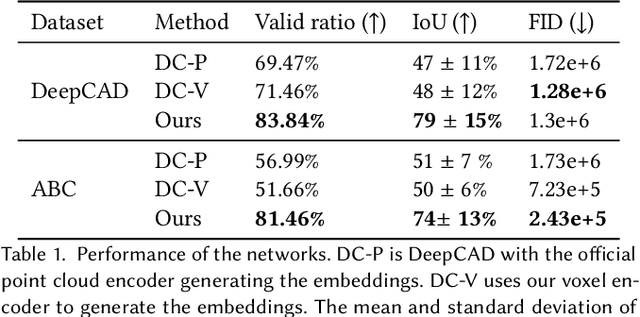
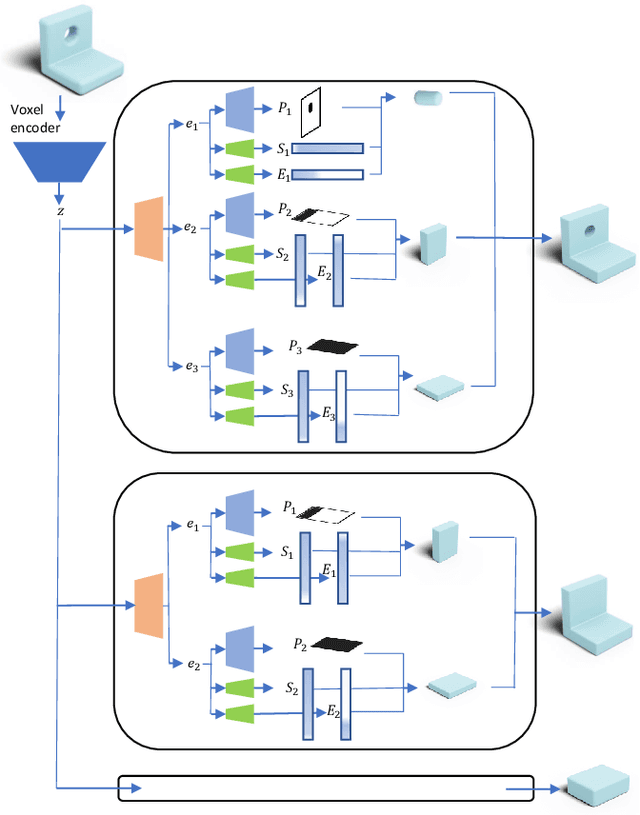
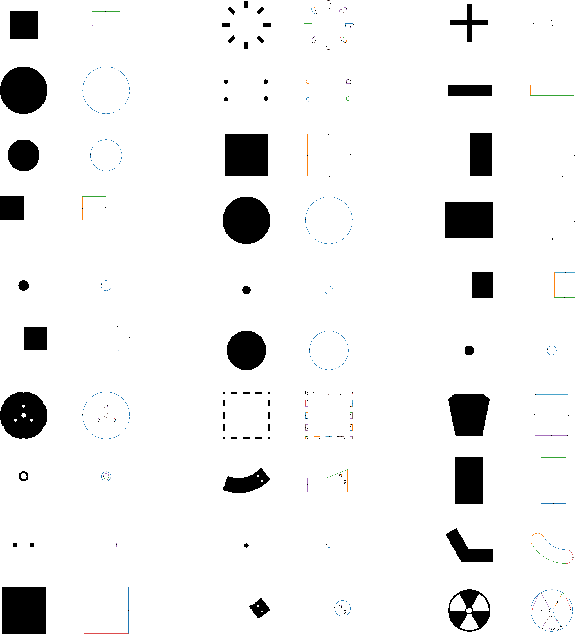
Abstract:Reverse Engineering a CAD shape from other representations is an important geometric processing step for many downstream applications. In this work, we introduce a novel neural network architecture to solve this challenging task and approximate a smoothed signed distance function with an editable, constrained, prismatic CAD model. During training, our method reconstructs the input geometry in the voxel space by decomposing the shape into a series of 2D profile images and 1D envelope functions. These can then be recombined in a differentiable way allowing a geometric loss function to be defined. During inference, we obtain the CAD data by first searching a database of 2D constrained sketches to find curves which approximate the profile images, then extrude them and use Boolean operations to build the final CAD model. Our method approximates the target shape more closely than other methods and outputs highly editable constrained parametric sketches which are compatible with existing CAD software.
SkexGen: Autoregressive Generation of CAD Construction Sequences with Disentangled Codebooks
Jul 11, 2022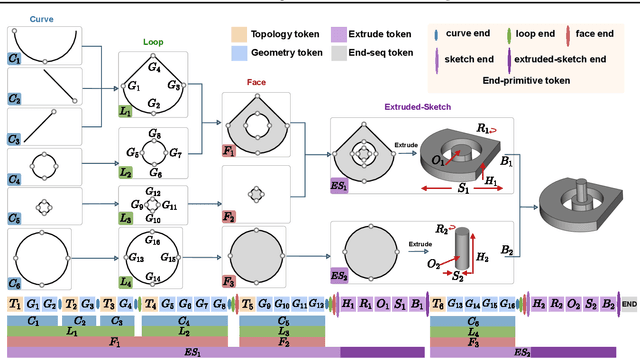
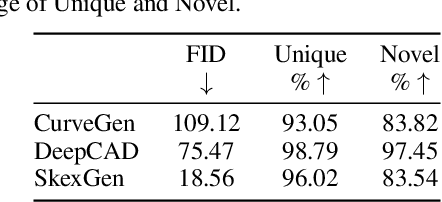
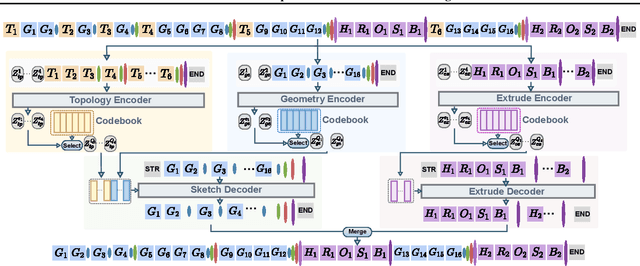
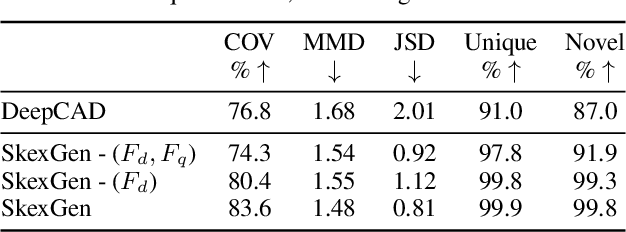
Abstract:We present SkexGen, a novel autoregressive generative model for computer-aided design (CAD) construction sequences containing sketch-and-extrude modeling operations. Our model utilizes distinct Transformer architectures to encode topological, geometric, and extrusion variations of construction sequences into disentangled codebooks. Autoregressive Transformer decoders generate CAD construction sequences sharing certain properties specified by the codebook vectors. Extensive experiments demonstrate that our disentangled codebook representation generates diverse and high-quality CAD models, enhances user control, and enables efficient exploration of the design space. The code is available at https://samxuxiang.github.io/skexgen.
SolidGen: An Autoregressive Model for Direct B-rep Synthesis
Mar 26, 2022



Abstract:The Boundary representation (B-rep) format is the de-facto shape representation in computer-aided design (CAD) to model watertight solid objects. Recent approaches to generating CAD models have focused on learning sketch-and-extrude modeling sequences that are executed by a solid modeling kernel in postprocess to recover a B-rep. In this paper we present a new approach that enables learning from and synthesizing B-reps without the need for supervision through CAD modeling sequence data. Our method SolidGen, is an autoregressive neural network that models the B-rep directly by predicting the vertices, edges and faces using Transformer-based and pointer neural networks. Key to achieving this is our Indexed Boundary Representation that references B-rep vertices, edges and faces in a well-defined hierarchy to capture the geometric and topological relations suitable for use with machine learning. SolidGen can be easily conditioned on contexts e.g., class labels thanks to its probabilistic modeling of the B-rep distribution. We demonstrate qualitatively, quantitatively and through perceptual evaluation by human subjects that SolidGen can produce high quality, realistic looking CAD models.
JoinABLe: Learning Bottom-up Assembly of Parametric CAD Joints
Nov 24, 2021



Abstract:Physical products are often complex assemblies combining a multitude of 3D parts modeled in computer-aided design (CAD) software. CAD designers build up these assemblies by aligning individual parts to one another using constraints called joints. In this paper we introduce JoinABLe, a learning-based method that assembles parts together to form joints. JoinABLe uses the weak supervision available in standard parametric CAD files without the help of object class labels or human guidance. Our results show that by making network predictions over a graph representation of solid models we can outperform multiple baseline methods with an accuracy (79.53%) that approaches human performance (80%). Finally, to support future research we release the Fusion 360 Gallery assembly dataset, containing assemblies with rich information on joints, contact surfaces, holes, and the underlying assembly graph structure.
CLIP-Forge: Towards Zero-Shot Text-to-Shape Generation
Oct 06, 2021
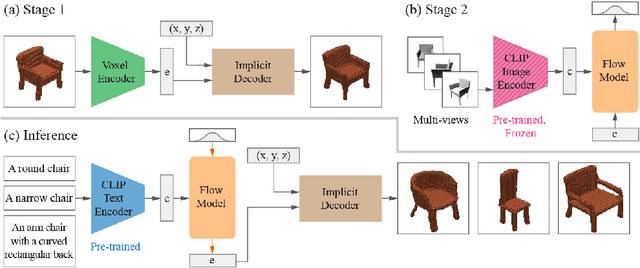
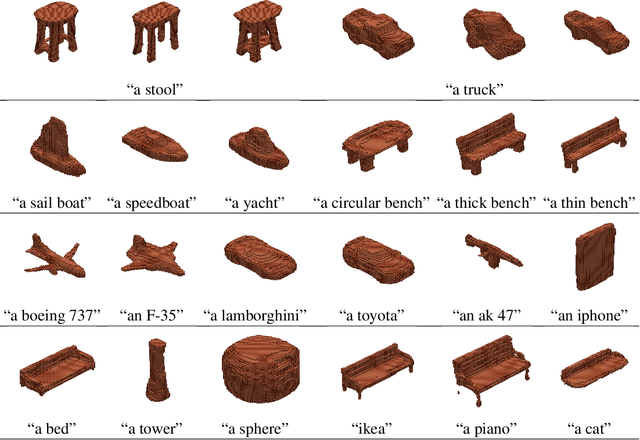

Abstract:While recent progress has been made in text-to-image generation, text-to-shape generation remains a challenging problem due to the unavailability of paired text and shape data at a large scale. We present a simple yet effective method for zero-shot text-to-shape generation based on a two-stage training process, which only depends on an unlabelled shape dataset and a pre-trained image-text network such as CLIP. Our method not only demonstrates promising zero-shot generalization, but also avoids expensive inference time optimization and can generate multiple shapes for a given text.
Engineering Sketch Generation for Computer-Aided Design
Apr 19, 2021



Abstract:Engineering sketches form the 2D basis of parametric Computer-Aided Design (CAD), the foremost modeling paradigm for manufactured objects. In this paper we tackle the problem of learning based engineering sketch generation as a first step towards synthesis and composition of parametric CAD models. We propose two generative models, CurveGen and TurtleGen, for engineering sketch generation. Both models generate curve primitives without the need for a sketch constraint solver and explicitly consider topology for downstream use with constraints and 3D CAD modeling operations. We find in our perceptual evaluation using human subjects that both CurveGen and TurtleGen produce more realistic engineering sketches when compared with the current state-of-the-art for engineering sketch generation.
BRepNet: A topological message passing system for solid models
Apr 08, 2021



Abstract:Boundary representation (B-rep) models are the standard way 3D shapes are described in Computer-Aided Design (CAD) applications. They combine lightweight parametric curves and surfaces with topological information which connects the geometric entities to describe manifolds. In this paper we introduce BRepNet, a neural network architecture designed to operate directly on B-rep data structures, avoiding the need to approximate the model as meshes or point clouds. BRepNet defines convolutional kernels with respect to oriented coedges in the data structure. In the neighborhood of each coedge, a small collection of faces, edges and coedges can be identified and patterns in the feature vectors from these entities detected by specific learnable parameters. In addition, to encourage further deep learning research with B-reps, we publish the Fusion 360 Gallery segmentation dataset. A collection of over 35,000 B-rep models annotated with information about the modeling operations which created each face. We demonstrate that BRepNet can segment these models with higher accuracy than methods working on meshes, and point clouds.
 Add to Chrome
Add to Chrome Add to Firefox
Add to Firefox Add to Edge
Add to Edge